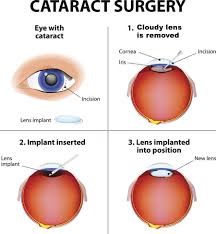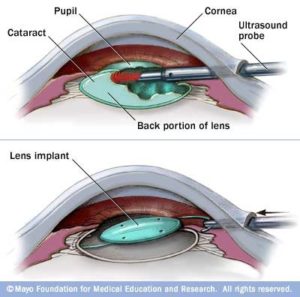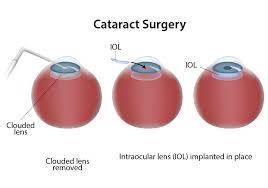Cataract Surgery Basics
A cataract is a clouding of the eye lens that can make it hard for you to see. The condition is most common in older people, but anyone can have one.
If your vision starts to cloud up, you can have your cataract removed and a plastic implant put in its place. That may sound scary, but it can improve your eyesight and make your life easier in lots of ways.
In cataract surgery, the lens inside your eye that has become cloudy is removed and replaced with an artificial lens (called an intraocular lens, or IOL) to restore clear vision.
The procedure typically is performed on an outpatient basis and does not require an overnight stay in a hospital or other care facility.
Most modern cataract procedures involve the use of a high-frequency ultrasound device that breaks up the cloudy lens into small pieces, which are then gently removed from the eye with suction.
This procedure, called phacoemulsification or “phaco,” can be performed with sm aller incisions than previous surgical techniques for cataract removal, promoting faster healing and reducing the risk of cataract surgery complications, such as a retinal detachment.
aller incisions than previous surgical techniques for cataract removal, promoting faster healing and reducing the risk of cataract surgery complications, such as a retinal detachment.
After all remnants of the cloudy lens have been removed from your eye, the cataract surgeon inserts a clear intraocular lens, positioning it securely behind the iris and pupil, in the same location your natural lens occupied. (In special cases, an IOL might be placed in front of the iris and pupil, but this is less common.)
Types of Cataracts
Cataract Surgery and types of cataracts:
Nuclear cataracts: Cataracts that affect the middle of the eye lens and characterized by increased nearsightedness at the onset, then a yellowing to browning of the lens that can make distinguishing colour shades difficult.
Posterior sub capsular cataracts: Cataracts that typically form at the back of the lens, interfering with the light’s path and usually causing reading difficulty, poor vision with bright light, and a halo or glare effect around lights at night
Cortical cataracts: Cataracts in which streaks or wedges begin on the outer lens of the eye and progress to the centre of the lens interfering with light entry and typically causing glare problems
Congenital cataracts: Cataracts which are present at birth often due to prenatal infection in the mother or a congenital medical condition such as rubella, my tonic dystrophy, Lowe’s syndrome, or galactosemia
Symptoms of Cataracts
Patients with cataracts often do not experience any symptoms when the condition first develops. Cataracts will continue to progress with no apparent pain, although patients may experience:
- Blurred or hazy vision
- Double vision
- Poor vision in bright light
- Seeing halos around lights
- Poor vision at night
- Yellowish tinged vision
- Frequent changes in eyeglasses or contact lens prescription
How Cataracts Form
Cataracts form when, as we age, the lenses of our eyes (located behind the irises, or colour portion of the eyes) become thicker and less flexible causing eye tissue to break down and cloud the lenses. As light enters the eye, the lens produces images onto the retina at the back of the eye. As more of the eye tissue breaks down, the cloudiness (cataract) scatters the light entering the lens and the images become less sharp thus blurring vision.
Cataracts generally occur in both eyes at a similar but not identical rate, but in some cases, may affect only one eye. Because cataracts often develop at a slightly different pace, one eye may require cataract surgery before the procedure is necessary on the other eye. Typically, cataract surgeries for both eyes are not performed at the same time, but are scheduled a few weeks apart, correcting the more affected eye first.
Who Should Have Surgery?
If you have a cataract, that doesn’t always mean you need surgery. You may not even notice any change in your vision. Some people who have this condition see just fine if they wear prescription glasses, use a magnifying lens, or rely on brighter lighting.
But as cataracts grow, they can cause more symptoms and cause problems in everyday life.
You could have dim, blurred, yellow, or double vision. This can make it hard to read, work on a computer, and anything else that calls for clear eyesight.
Other treatments for cataract Surgery
Cataracts can only be removed with surgery. There are no medicines or eye drops that can improve cataracts. When cataracts interfere with your ability to read, drive, or do the things you enjoy, cataract surgery is a safe, effective, and relatively pain-free option to improve your vision.
Laser cataract surgery
Not all cataracts need surgery. If your symptoms are mild, a new glasses prescription may improve your vision. After your eye exam, the doctors at Coleman Eye Centre can help you decide the best way to improve your vision.
These lasers have gained approval for the following steps in cataract surgery, reducing the need for surgical blades and other hand-held tools:
- Creating corneal incisions to allow the surgeon access to the lens
- Removing the anterior capsule of the lens
- Fragmenting the cataract (so less phaco energy is required to break it up and remove it)
- Creating peripheral corneal incisions to reduce astigmatism (when needed)
Laser cataract surgery (or, more accurately, laser-assisted cataract surgery) is fairly new and significantly increases cataract surgery cost, primarily because the laser can cost from $300,000 to $500,000 for a surgeon to purchase and there are other significant costs associated with the use and maintenance of this technology.
While studies have shown that lasers can improve accuracy during certain steps of cataract surgery, they may not necessarily improve cataract surgery safety, recovery time and visual outcomes in every case.
For the latest information about laser cataract surgery, ask your eye doctor during your preoperative eye exam and cataract surgery consultation.
The procedure
Cataract surgery is a common and relatively straightforward procedure that usually takes up to 30 to 45 minutes.
It’s usually carried out as day surgery under local anaesthetic, which means you’re conscious during the procedure and can go home on the same day.
The most common surgical technique used is known as phacoemulsification.
Before the operation, a nurse will put drops in your eye to widen (dilate) your pupil.
You’ll also be given a local anaesthetic, which can be applied as eye drops or given as an injection into the tissue around your eye. The surgeon will make a tiny cut in your cornea, the transparent layer of tissue at the front of your eye.
A small probe that emits ultrasound waves is inserted through your cornea into the eye to break the affected lens into pieces. The pieces are then liquefied and sucked out. A second probe sucks out the remaining soft pieces of outer lens. After the affected lens has been removed, the surgeon will insert a small plastic lens in its place.
The replacement lens is usually curled up in an injector and injected through the cut in the cornea. When it’s in place, it unfolds itself and adopts the natural position of the old lens.
In a few cases, it may be necessary to make a slightly larger incision in the eye to replace the affected lens, which may need to be closed with tiny stitches that are removed a few weeks later.
How Surgery takes place?
First, your doctor will numb your eye with anesthetic, meaning you will be awake for the procedure. He may also give you medicine to help you relax.
He’ll make a tiny cut in the front of your eye. Through this, he’ll insert a small tool to break up the cataract and gently suction it out. Then, he’ll insert the new lens implant, which is made of plastic, silicone or acrylic, and close the incision. Your doctor may sew in stitches.
You won’t need to stay overnight at the hospital. Cataract surgery is done as an outpatient procedure. But you will need someone to drive you home.
If you have cataracts in both eyes, you’ll probably be scheduled for two separate surgeries, typically a few weeks apart. This gives the first eye a chance to heal.
Side effects
- Eye infection or swelling
- Bleeding
- Retinal detachment
- Feeling of pressure inside your eye
- Loosening of new implant
- Fluid build-up in eye
- Drooping eyelid
Risks
All surgeries carry some degree of risk. Fortunately, cataract surgery is one of the safest and most commonly performed surgeries in the United States. Having performed tens of thousands of cataract surgeries, the surgeons at Coleman Eye Centre minimize risk through careful surgical planning, skilful technique, and the use of advanced technology.
The doctors and staff at Coleman Eye Centre will discuss the risks and benefits of cataract surgery with you at the time of your examination, and will also highlight any special features or concerns regarding your surgery.
After Surgery
Your eye may itch or feel sore for a few days after. It’s also common to have some fluid discharge. You might also find it hard to see well in bright light.
Your doctor will give you eye drops to prevent infection. You’ll need to take it easy for a few days. Driving will be off-limits, and you shouldn’t bend over, pick up heavy things, or put any pressure on your eye.
For the first week, your doctor will likely recommend sleeping in an eye shield. T his will protect the site of your surgery so your eye can heal. If you’re in pain or feel your eye isn’t healing like it should, tell your doctor right away.
his will protect the site of your surgery so your eye can heal. If you’re in pain or feel your eye isn’t healing like it should, tell your doctor right away.
After 8 weeks, your eye should be fully healed. About 90% of people see better after cataract surgery. But don’t expect your vision to be perfect — you may still need to wear glasses or contacts.
IS CATARACT SURGERY PAINFUL?
Most patients experience very little discomfort during their operation. You will be given an oral medication to help you relax as well as local anesthetic around the eye to prevent pain, movement, and vision in your eye during the surgery. Being put to sleep with general anaesthesia is not needed during cataract surgery.
Recovery
Immediately after surgery, a patch is placed over the eye and will remain for a few hours. After the patch is removed, post-operative eye drops are begun. Patients usually enjoy resting on the day of surgery.
The day after surgery, patients will have a post-operative visit. Specific questions about activity levels can be answered at this time, but typically most normal activities can then be resumed. Most patients feel very little discomfort during the recovery period.
Visual recovery will vary from patient to patient, but most patients will see well as early as the first day after their cataract surgery. Vision will usually continue to improve in the days following surgery.
Cataract Surgery – How affordable it is?
The expenditure involved in cataract surgery mainly depends upon the IOL used. As for example, a monofocal IOL can be obtained with lesser expenses as compared to presbyopia correcting lens. However, while the monofocal IOL may need reading glasses eventually, presbyopia lenses do not need any such aids.
In addition, the city you live in and the lifestyle followed can also influence the cost of surgery. To get a comparative study of cataract surgery costs in various cities across India, you may refer here. Besides, your expenditure also depends upon the hospitals, the facilities available and the surgeon concerned.
Nevertheless, cataract surgeries in India do not have sky-touching rates. They are more or less affordable and therefore, need to be opted for as a cost-effective treatment procedure.
Well, no matter at what age you start experiencing cataract issues, a clear vision is always desired. Rather, old age demands for a better eyesight to eliminate causes of mishaps. Moreover, the world is still a beautiful place and has loads to explore. Would you like to leave it unseen just because you have a cataract disorder that is otherwise treatable and of course affordable? Perhaps NO. Isn’t it?
